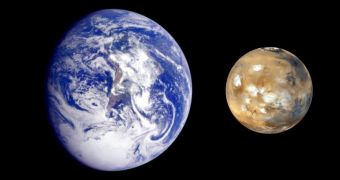A research led by Conel Alexander and Jianhua Wang from the Carnegie Institution for Science shows that the building blocks composing Mars have a structure comparable to that of Earth.
It appears the two planets' forming was similar, although their following development differed, Mars Daily reports.
According to researchers, this indicates that chondritic meteorites should be a common water source for all the telluric planets, including Earth and Mars.
The study gathered scientists from NASA's Johnson Space Center in Huston, Carnegie and Huston's Lunar and Planetary Institute in a struggle to get closer to the revealing of what is currently the most stringent and controversial matter among planetary scientists – the Martian water's history.
The experiment used crystals from two Martian meteorites in order to observe the liquid concentration and the hydrogen isotopic compound existing within.
One of the meteorites, whose hydrogen isotopic configuration proved to be comparable to that of Earth, illustrated water in the state it existed at the time of Mars' forming as a planet. The other, having entered in contact with the Martian atmosphere, sampled nothing but superficial crust and atmosphere.
“The hydrogen isotopic composition of the water in the enriched meteorite clearly indicates that they have been overprinted, so this meteorite tells scientists more about the Martian crust than about the Martian mantle,” explained Prof. Alexander, head-leader of the study, as cited by Science Daily.
“Conversely, the other meteorite yields more information about the Martian interior,” he added.
The two meteorites are representative for two different Martian environments: its deep interior and its surface. Observing how the water concentration differs from one meteorite to another, researchers say there is a possibility that Martian surface was once not as dry as we now know it.
Even if the study brings a great contribution to the extremely complex Martian researches currently conducted, “to understand the geologic history of Mars, more information about both of these environments is needed,” as Prof. Alexander said.

 14 DAY TRIAL //
14 DAY TRIAL //